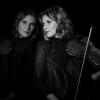
What’s better than one headliner? Three. It was good branding for Sunday’s trio concert at Davies Symphony Hall, which featured violinist Lisa Batiashvili, cellist Gautier Capuçon, and pianist Jean-Yves Thibaudet. (The trio was at Walt Disney Concert Hall with the same program the Wednesday before.) It was also an accurate description — often, they did sound like three soloists. The more they play together, the deeper their interpretations will delve. For now, they’re plenty novel.
The first two pieces, played in much the same way, sounded oddly new: a late Haydn trio, which was unusually romantic, and Maurice Ravel’s Piano Trio, which was prettily temperate. The opening chords of Haydn’s Piano Trio No. 44 in E Major — the strings plucking along to the piano’s flung grace notes — may evoke the harpsichords that, some 30 years prior, would have played the composer’s first trios. But now it’s 1797. When the melody repeats, thickly voiced and on Sunday played by Thibaudet with beautiful legato, it’s as if the piano is making its society debut.

Here, as in Haydn’s earlier trios, most of the lines are doubled. In the right hands, though, these redundancies sound radical. Take the Allegretto second movement. The miry unison line at first seems like a nonstarter — yet five bars later, it’s revealed as the accompaniment for the piano’s right-hand aria, which Thibaudet phrased with just-right pathos. When the three musicians came together again, it was practically impossible to tell where one player ended and the other began.
The finale whirls, too. Haydn exploits the ambiguity of an incomplete chord to make a bewildering modulation and then smacks you with it in a dizzying vamp. On Sunday, though, the most heart-stopping moment was the penultimate string of chords pulled almost to their breaking points, like globs of caramel.
It’s in a similar way that Ravel roots us in place in his Piano Trio. With extended stays in a single key, the first movement exists in a dream realm. Batiashvili’s sotto voce high-register playing, especially, had the mist of a protective shroud.
Ravel wrote this music in 1914 in a fever, hurrying to enlist in World War I. (Too old for the French Air Force, he nevertheless served as a driver on the front line). But you wouldn’t guess it listening to the meditative Passacaille, whose mounting variations seem to encompass the gamut of experience. The voices reach out, come together, only to break apart. Under Thibaudet, the final notes weren’t as dire as they sometimes are. Was the finale, then, more ebullient? It was hard to tell.
Some of Ravel’s articulations were glossed over, the first movement’s strange lilt just a bit flattened. And by the time we’d gotten to the last piece, Felix Mendelssohn’s Piano Trio No. 2 in C Minor, the strings’ basically continuous portato struck me as ineffectively decorative, like too much tufting on a Chesterfield sofa. For Mendelssohn especially — the upright, openhearted composer of Songs Without Words — so much emphasis can feel self-indulgent. Still, the Scherzo gleamed, and the finale of Antonín Dvořák’s “Dumky” Trio made a blazing encore. Let’s hope this trio returns with the whole thing.




